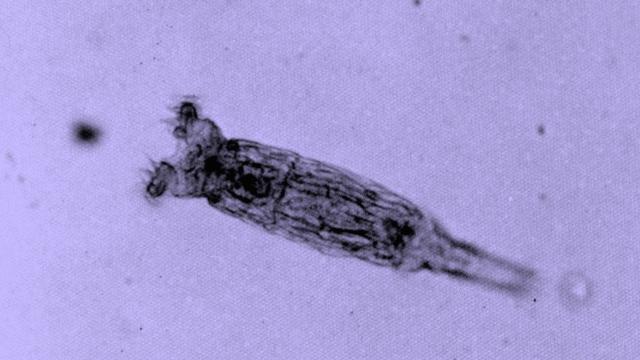Chances are, you’ve never heard of bdelloid rotifers, strange microscopic creatures that typically live in freshwater ponds and streams. In the grand scheme of things, they’re related to arthropods, a group which includes insects, spiders, and crustaceans. But honestly, they’re in a unique class all their own. And they don’t have sex.
I don’t read many papers that completely blow my effing mind. This Genetics paper about bdelloids is one of them. A group of biologists, led by Matthew Meselson (the same guy we can thank for showing us that chromosomes get one strand of DNA from each parent), found evidence of sexual recombination — also known as sex to you and I — in the (relatively) recent past of one group of bdelloids.
Here’s why it’s mind-blowing: bdelloid rotifers reproduce by cloning themselves. As far as anyone could tell, every single one of them is female. No one has ever found an individual that could conclusively be called a male, or even one that looks like it could be a hermaphrodite. And that implies that for somewhere between 40 and 100 million years (the timing is hazy), individuals in this class of rotifer have been happily cloning and recloning themselves over and over again.
For most animals, that’s a recipe for disaster: when chromosomes are isolated from the repair steps of recombination they collect more and more random mutations over time. Sooner or later, one of them is bound to break a gene critical to survival. But the bdelloids seemed to have found other, weirder ways to recombine their genes, sometimes by breaking their chromosomes into pieces and reshuffling the bits, or in some cases by hoovering up random chunks of DNA from their environment and pasting it into their genomes.
So when the authors compared the genomes of clone lines collected from around the Northeast US and North Carolina, they must have been pretty surprised to find some gene sequences that were completely (or close to it) identical in three of the lines. If this was true of just one gene, it might have just been traded in one of the rotifer’s weird DNA-as-trading-cards shticks. But one of the clone lines (MA, collected on Long Island, NY) shared four genes with other lines. Even more amazing, one copy of those four genes were identical to a gene from a second clone line (designated MM and collected in Woods Hole, MA), and its other copy was a close match to a gene from a third, more distantly related clone line (CR, collected in Cambridge, MA). The only way that the ur-clone of MA could get this pattern in all four of the genes they checked is by inheriting those genes from two parents.
Let’s make this clear: nobody has surprised a pair of bdelloids mid-coitus. Nobody’s even found a bdelloid that looks like it could be a male or hermaphroditic. And all the bdelloids in this study are still cloning themselves. But there’s now strong indirect evidence that under some as-yet-not-understood conditions, these odd little animals that can spend decades or centuries cloning themselves somehow revert to reproducing the old-fashioned way, then switch back to cloning.
I’ll be over here in the corner, stuffing my brains back into my head.
[Signorovitch et al. 2015; h/t Ben Ewen-Campen at Sick Papes]
Picture: Ian Sutton via Flickr
